
Now available
Gagosian Quarterly Fall 2022
The Fall 2022 issue of Gagosian Quarterly is now available, featuring Jordan Wolfson’s House with Face (2017) on its cover.
Spring 2018 Issue
In the small skiing village of Gstaad, among the towering mountains of the Swiss Alps, lies a surprising and ambitious exhibition of sculpture by Giuseppe Penone. Susan Ellicott tells the story of how this installation came to be.
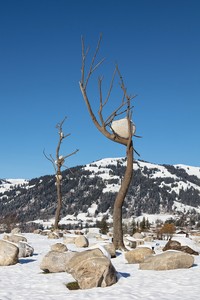
Giuseppe Penone’s Idee di pietra — Olmo (2008) and Idee di pietra — Ciliegio (2011) on view in Gstaad, Switzerland, December 13, 2017–March 30, 2018. Photo: Marcus Veith
Giuseppe Penone’s Idee di pietra — Olmo (2008) and Idee di pietra — Ciliegio (2011) on view in Gstaad, Switzerland, December 13, 2017–March 30, 2018. Photo: Marcus Veith
In choosing a Swiss meadow to show Idee di pietra — Olmo (Ideas of Stone—Elm Tree, 2008) and Idee di pietra — Ciliegio (Ideas of Stone—Cherry Tree, 2011), Giuseppe Penone invites us to wonder: how did these works—two large-scale bronze sculptures of trees, accompanied by boulders strewn across the sloping ground like debris dumped by a glacier—get here?
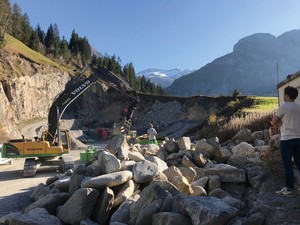
The stone quarry where approximately fifty stones were selected for the installation. Photo: Antonello Martella
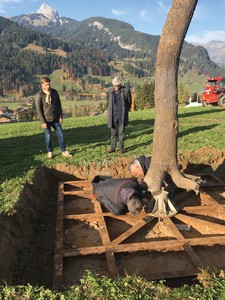
The artist watches over as the base of one of the sculptures is secured and installed into the ground. Photo: Elly Sistovaris
The short, easy answer is through meticulous planning. Bronze trees up to fifty or so feet high, and fifty river stones from a nearby quarry, don’t find their way into a dramatic Alpine field facing the Hotel Le Grand Chalet in Gstaad, one of Switzerland’s most famous resorts, without logistical coordination.
This is the first time works from Penone’s Idee di pietra series had been staged in a rural landscape in winter weather. The installation took three full days to set up and involved several trucks, two forklifts, a wheeled crane with a cherry picker for two, and many specialist tools. Two of the original trucks proved too big to drive through local streets, and the crane too short to assemble the taller tree, so a forklift did the job. “The result is breathtaking,” says Cyprien David, a gallery assistant at Gagosian in Geneva who worked on the installation. “We certainly had challenges, but, luckily, the artist and crew remained steadfast and confident throughout. We all got the sense Giuseppe is very comfortable with these installs and he had a sense of humor about it all. The process was very collaborative.”

View of the installation grounds, Gstaad, Switzerland, October 2017. Photo: Antonello Martella
The first snowfall covered all traces of the installation—footprints, mud, tire tracks from the vehicles—so that the trees appeared to grow from the ground.
Overall, the effect of the installation is at once magical, surreal, and serious. The very exactness of the textured trunks and branches invites us to question whether they’re real, just as the village of Gstaad looks from the hotel like a model, an artificial backdrop. First-time visitors do a double take: two giant trees stand alone in a treeless landscape. What’s their story—are they together? Survivors? That boulder balanced over our heads in Ciliegio . . . how? The imposing outdoor location adds to the mystique: the postcard mountains and changing skies are part of the drama. When snow clings to the boulder, we wonder whether or not it’s fake.
That we can see the trees assembled as Penone imagined them is a testament to nonverbal communication. The artist directed an on-site team of French-, Swiss-German-, and Italian-speaking technicians, gallerists, and installers; they had no common language. “We collaborated with drawings and hand signals. It took a lot of concentration, especially for those of us up in the air,” says David.
The team had instructions on how to fit the sections of the bronze trees together and how deep to dig the holes for the bases. Even so, setting up such works on soft, uneven terrain was always going to require some improvisation. “These are among the most powerful and complex sculptures in the artist’s oeuvre,” says Pepi Marchetti Franchi, a Gagosian director who works closely with Penone. “The size and weight of multiple bronze elements and the stones make these challenging artworks to maneuver.”
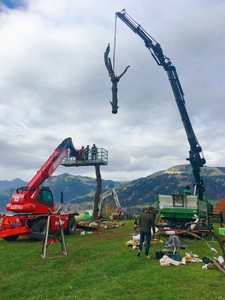
A crane is used to lower the midsection of Idee di pietra — Ciliegio onto the trunk. Photo: Elly Sistovaris

An installer secures a stone onto one of the branches of Idee di pietra — Ciliegio. Photo: Antonello Martella
One of the biggest challenges, though, was something quite unexpected. One day before the setup date, local officials told the team they couldn’t use a parking lot 200 yards from the site because their Italian trucks were too big for Gstaad’s tiny historic streets. The team would have to park half a mile away, five times the original distance. “We were scared,” says David. “We couldn’t see how to carry the heavy sculptures to the meadow from so far away.” Fortunately, he learned, Gstaad is like “a big family.” One of the Swiss-German-speaking drivers called a friend: within minutes, he’d found a substitute truck small enough to drive to the preferred lot. “That saved us,” says David. “Somehow our teams always find a solution.”
Olmo is one solid piece of bronze, while Ciliegio, the larger work, stands over fifty feet tall when assembled, travels in sections, and breaks down into three trunk parts and four branches. Bringing these heavy sculptures uphill presented difficulties—one truck got stuck in the early-winter mud—but once at the site, the works were mostly straightforward to erect. The installer for Ciliegio, though—not from the sculpture’s foundry—didn’t have the precision tool to screw the trunk into its base and had to modify his own. “With installations, there’s always something to overcome,” says David. “The challenges are part of the fun. Giuseppe was really involved, always smiling and encouraging.”
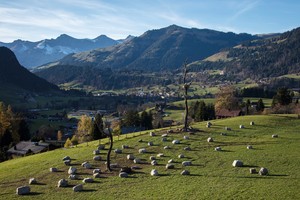
View overlooking the sculptures in dialogue with the landscape of the Swiss Alps. Photo: Marcus Veith
The final challenge was to get a rock into the crook of the lowest fork of Ciliegio. For over an hour the team was unable to make holes drilled directly into the rock align with metal sticks welded into the trunk. “It sounds easy,” says David, “but it’s not when you’re ten meters up.” By five in the afternoon, time was running out. It would be dark by six and the next day’s forecast was for snow, which would make it impossible to work. “Giuseppe was below, calling, ‘Let’s give it one last shot,’” recalls David. “It was exciting. Finally, we did it, which was just as well because it wouldn’t have been possible for a week with the bad weather coming in. We were lucky.”
Artwork © Giuseppe Penone; Giuseppe Penone: Idee di Pietra, Gstaad, Switzerland, December 13, 2017–March 30, 2018

A writer, filmmaker, broadcaster, and food entrepreneur, Susan Ellicott travels frequently between the US and London on assignment. A former on-air correspondent for the BBC, ABC News, and NPR, she recently appeared in a series of Japanese television films on artisan food in Japan. Last year she worked as a filmmaker for Stanford University and as a judge of chef cook-offs at crab and abalone festivals in Mendocino.

The Fall 2022 issue of Gagosian Quarterly is now available, featuring Jordan Wolfson’s House with Face (2017) on its cover.
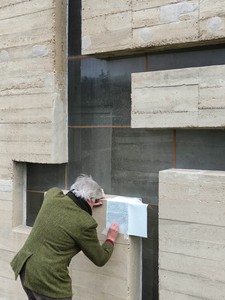
Le Couvent Sainte-Marie de La Tourette, in Éveux, France, is both an active Dominican priory and the last building designed by Le Corbusier. As a result, the priory, completed in 1961, is a center both religious and architectural, a site of spiritual significance and a magnetic draw for artists, writers, architects, and others. This fall, at the invitation of Frère Marc Chauveau, Giuseppe Penone will be exhibiting a selection of existing sculptures at La Tourette alongside new work directly inspired by the context and materials of the building. Here, Penone and Frère Chauveau discuss the power and peculiarities of the space, as well as the artwork that will be exhibited there.

As spring approaches in the Northern Hemisphere, Sydney Stutterheim reflects on the iconography and symbolism of the season in art both past and present.
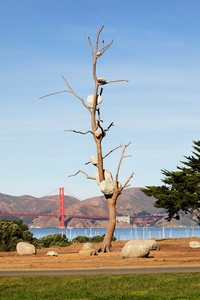
Elizabeth Mangini writes on Giuseppe Penone’s installation of two sculptures at San Francisco’s Fort Mason.
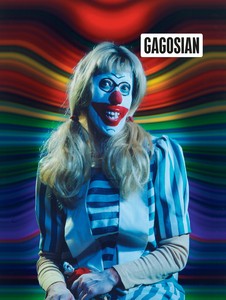
The Spring 2020 issue of Gagosian Quarterly is now available, featuring Cindy Sherman’s Untitled #412 (2003) on its cover.
An outdoor installation by Giuseppe Penone in San Francisco’s historic Fort Mason features two life-size bronze sculptures cast from fallen trees. The project continues the artist’s long investigation of the perpetual give-and-take between humans and nature. In this video, Penone discusses what drew him to this landscape and the concepts behind the installation.
Gagosian director Pepi Marchetti Franchi speaks about Giuseppe Penone’s recent exhibition in San Francisco, detailing the various works and their relationships to the artist’s long-standing sculptural practice.
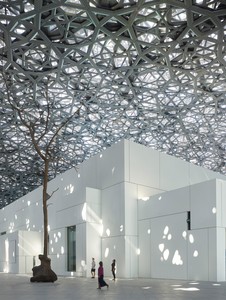
One year after the opening of the Louvre Abu Dhabi, Jean Nouvel and Giuseppe Penone sat down with Alain Fleischer, Pepi Marchetti Franchi, and Hala Wardé to reflect on how the museum and Penone’s commissioned artworks for the space came to be.
Jenny Saville reveals the process behind her new self-portrait, painted in response to Rembrandt’s masterpiece Self-Portrait with Two Circles.
Giuseppe Penone discusses his new monograph, The Inner Life of Forms, with the book’s editor Carlos Basualdo, senior curator of contemporary art at the Philadelphia Museum of Art, at the Greene Space, New York. Hosted by art critic Deborah Solomon.
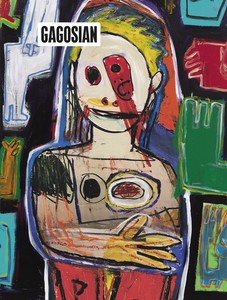
The Winter 2018 issue of Gagosian Quarterly is now available. Our cover this issue comes from High Times, a new body of work by Richard Prince.
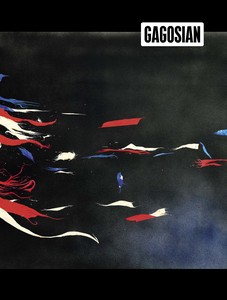
The Spring 2018 Gagosian Quarterly with a cover by Ed Ruscha is now available for order.